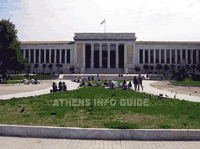
National
Archaeological Museum
The
National Archaeological Museum, the largest and most representative
in Greece, is situated in the center of the city in a block between
Tossitsa Street, Ipirou Street, Bouboulinas Street and 28 October
(Patission) Street where the museum’s entrance is.
It
was built in three stages in the second half of the 19th century
and, despite numerous alterations and additions made in order
to serve new requirements, the building basically retains its
neoclassical style. The need to create an archaeological museum
was felt already since the foundation of the modern Greek State.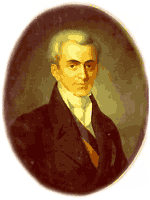
The
first such museum was founded by Ioannis Kapodistrias in Aegina
in 1829 and as soon as Athens became the state capital, the archaeological
collections were housed in different premises (the Hephaisteion,
the University and the Technical University). In 1858, an international
architectural competition to select the location and the design
of the museum took place but with no result.
In
1865, Eleni Tositsa donated a large piece of land near the Technical
University for the construction of the building. There had been
a large sum of money for the building available since 1858. It
was donated by Dimitrios Vernardakis from Saint Petersburg. The
construction began in 1866 and was completed in 1880.
The
initial designs were made by the German architect Ludwig Lange
and, with some alterations, they were realized by Panagiotis Chalkos,
the architect in charge. The western wing of the so called “Central
Museum” was completed in 1874. At the initiative of Charlaos
Trikoupis, the museum was renamed “National Archaeological
Museum” in 1881. The southern wing was completed four years
later and the eastern wing in 1889.
The
famous architect Ernst Ziller took over the final stages of the
project in 1888. He redesigned the building’s façade
and made several alterations to the original design. In 1891,
the Archaeological Society donated the archaeological finds collected
from various excavation projects in Greece to the museum. With
the many archaeological finds in the 20th century, the museum
had to be expanded. The small houses on the eastern side and the
apse of the initial building had to be demolished and the construction
of the eastern two-storey wing, designed by G. Nomikos, was finished
in 1939. All offices were transferred there.
During
World War II, all the antiquities were placed in boxes and were
buried. They were gradually put back on display between 1945 and
1964 under supervision of director Christos Karouzos. At the same
time, storehouses were built at the north wing of the old building.
The building suffered heavy damages with the 1999 earthquake.
Subsequently, the museum closed for the public in order to be
rearranged in view of the 2004 Olympic Games. Since June 2004
part of the permanent collections was on display for the public.
One year later all collections were on display again on both floors
of the museum. 
Prehistoric Collection
 The
Prehistoric collection is displayed in rooms 3 to 6 on the ground
floor. In room 5 there are Neolithic objects (6800-3300 BC) and
objects from the early and mid-Bronze period (3rd century BC and
2000-1700 BC). There are ceramic finds from the important Neolithic
sites at Dimini and Sesklo in Thessaly as well as early and middle
Helladic ceramics from various locations in Boeotia, Attica and
Phthiotis. Some objects from Schliemann’s excavations in
Troy are also on display. The
Prehistoric collection is displayed in rooms 3 to 6 on the ground
floor. In room 5 there are Neolithic objects (6800-3300 BC) and
objects from the early and mid-Bronze period (3rd century BC and
2000-1700 BC). There are ceramic finds from the important Neolithic
sites at Dimini and Sesklo in Thessaly as well as early and middle
Helladic ceramics from various locations in Boeotia, Attica and
Phthiotis. Some objects from Schliemann’s excavations in
Troy are also on display.
Room
6 houses the Cycladic collection with the famous marble figurines
from cemeteries of the 3rd century BC together with numerous bronze
tools and containers. Items that are representative of the Mycenaean
civilization are on display in room 4 and the smaller room 3.
Among them, the excellent 16th century BC finds that Schliemann
excavated from the Mycenaean circle A graves as well as finds
from the earlier circle B graves, stand out.
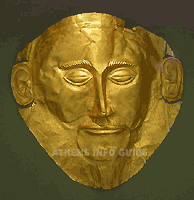 Most
notable are: Most
notable are:
•
the gold funerary masks covering the faces of deceased
leaders
• stone relief stelae
• golden containers
• silver
• electrum (an alloy of gold and silver)
• crystal and alabaster
• golden and amber jewels
• small bronze knives decorated with gold and silver
inlays showing battles and hunting scenes.
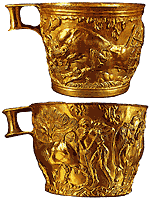 There
also are finds from the vaulted tombs in Mycenae and other locations
in the Peloponnese (Tiryns and Dendra in Argolis, Pylos in Messinia
and Vafeio in Lakonia) including stone, bronze and ceramic pots,
figurines, ivory objects, golden seals and rings with precious
and semi-precious stones, glass and faience. There
also are finds from the vaulted tombs in Mycenae and other locations
in the Peloponnese (Tiryns and Dendra in Argolis, Pylos in Messinia
and Vafeio in Lakonia) including stone, bronze and ceramic pots,
figurines, ivory objects, golden seals and rings with precious
and semi-precious stones, glass and faience.
Items
that attract a lot of the visitor’s attention are two golden
cups in relief decoration from Vafeio showing scenes of the capture
of a bull. There are also finds from the citadel of Mycenae such
as a group in ivory showing two goddesses with a child, a painted
limestone head of a goddess and the famous warrior’s vase
dating from the 12th century. 
Sculpture collection
The
major part of the rooms of the ground floor is devoted to the
exhibition of sculpture from the 7th century BC to the Roman period.
The rooms have been arranged in chronological order. In room 7
visitors can see sculpture of the daedalic style, dating from
the 7th century BC including the poros metopes from Athena’s
Temple in Mycenae and the kore (statue of a girl) dedicated by
Nikandre from Naxos to the goddess Artemis at Delos. This is the
earliest know life-size statue in ancient Greek sculpture.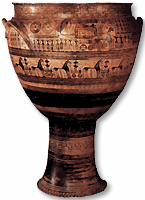
The
room is dominated by the colossal Geometric Amphora attributed
to the Dipylon painter, one of the first Greek works of art to
show the human figure (750 BC), representing the exposition of
the body of the dead and the mourning in his honor. In rooms 8-13
are the Archaic Sculptures from the end of the 7th century BC
until the beginning of the 5th century BC. Important are the kouroi
(statues of boys) from Sounio, Anavyssos and Volomandra in Attica,
Melos and the sanctuary of Ptoon in Boeotia, including the important
grave statue of Aristodikos from 500 BC which marks the liberation
of the human figure from archaic stillness and preconises the
Classical art. Equally important is the statue of Phrasikleia
(kore), discovered in Merenta in Attica.
In
rooms 14 and 15 are works belonging to the severe style (480-450
BC), including the votive stele of an athlete from Sounio placing
a wreath on his head and a relief from Eleusis, showing Dementer,
Persephone and Triptilotemos. Room 15 is dominated by the famous
bronze statue of Zeus, or Poseidon, from Artemision in Euboea
dating from 460 BC and attributed to the sculptor Klamamis.
In
room 16 there are gravestones from cemeteries in Attica including
that of a young man from Salamis from 430 BC. Room 17 has parts
of metopes, sculptures from the decoration of the Temple of Hera
in Argos with scenes of Greeks fighting the Amazons and a marble
head from the statue of a goddess.
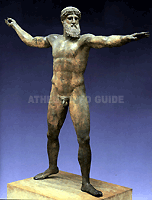 Room
18 displays gravestones including that of Hegeso (end of the 5th
century BC) from the cemetery of Kerameikos. The dead woman is
shown seated opposite a slave who is holding a jewel case (pyxis).
Rooms 19 and 20 include works from the Roman period, copies of
famous bronze sculptures of the Classical period. The importance
of the statue of Varvakeios Athena (3rd century BC) lays more
in its being a copy of the gold and ivory statue of Athena form
the Parthenon made by Pheidias, than in its aesthetic value. Room
18 displays gravestones including that of Hegeso (end of the 5th
century BC) from the cemetery of Kerameikos. The dead woman is
shown seated opposite a slave who is holding a jewel case (pyxis).
Rooms 19 and 20 include works from the Roman period, copies of
famous bronze sculptures of the Classical period. The importance
of the statue of Varvakeios Athena (3rd century BC) lays more
in its being a copy of the gold and ivory statue of Athena form
the Parthenon made by Pheidias, than in its aesthetic value.
Two
well known pieces are displayed in room 21 on the way from the
ground-floor to the first floor. The statue of Diadoumenos, a
marble Roman copy of a work by the sculptor Polykleitos from Argos
(mid-fifth century BC) and the copper statue of a jockey from
Artemison dating from the mid-2nd century BC. In room 34, on the
other side of the staircase that leads up to the first floor,
there are several stelae and a marble altar on display. Room 22
has architectural sculptures from the Temple of Asklepios in Epidaurus
that date from the 4th century BC while in room 23 and 24 gravestones
of the 4th century BC are on display including the excellent gravestone
of Ilissos (ca. 340 BC), made by the workshop of the famous sculptor
Skopas.
Rooms
25 to 27 include votive reliefs from various areas of Greece as
well as documentary and honorary reliefs from Attica. In Room
28 you’ll see works from the late Classical period (4th
century BC) such as the bronze statue of a young man from Marathon,
possibly made by B. Praxiteles, and the bronze statue of a boy
in his teens from Antikythira, sculpted by Euphramor, both dating
from ca. 340-330 BC as well as the gravestone of Aristonautes.
Rooms
29-33 have bronze and marble statues from the Hellenistic
and Roman periods including the famous statue of Poseidon
from Melos, the colossal statues of Dampphon from the Temple
of Despoina in Lykosoura (Arkadia), the “wounded Galatian’ and
the group of Aphrodite and Pan from Delos. The bronze statue
of Octavianus and the bust of Antinous, Emperor’s Hadrian’s
protégé.

Bronze collection
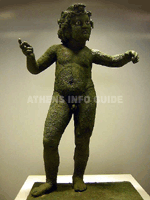 The
antiquities on display in room 36 once belonged to Konstantinos
Karaponas, a politician and amateur archaeologist from Ipiros.
They come from the excavations he conducted himself in Dodone
and Corfu but from purchase as well. The collection includes excellent
bronze objects, mostly statuettes, such as: The
antiquities on display in room 36 once belonged to Konstantinos
Karaponas, a politician and amateur archaeologist from Ipiros.
They come from the excavations he conducted himself in Dodone
and Corfu but from purchase as well. The collection includes excellent
bronze objects, mostly statuettes, such as:
•
the young man on a horse from Dodone (550-540 BC)
• a woman wearing the peplos from Pindos (460 BC)
• a dancing satyr created by a Corinthian workshop (second
half
of the 6th century BC)
There
also are inscribed metal sheets, tools, mirrors, implements, weapons
and fragments of large bronze containers from Dodone, terracotta
figurines and small tablets from the lesser sanctuary of Artemis
in Corfu as well as the heads from Roman statues and Attic gravestones.
In
room 37 there also are bronze objects on display from various
areas of Greece (statuettes, containers, implements, weapons)
from Geometric and Early Archaic periods as well as jewelry made
of precious metals mostly found in sanctuaries. Rooms 37a, 38
and 39 display bronze objects, mostly statuettes of athletes and
animals as well as fragments of containers from the sanctuaries
of the Acropolis and Olympia. 
Egyptian collection
The
Egyptian collection is housed in rooms 40 and 41. It consists
mainly of donations from two Greeks who lived in Egypt, Ioannis
Dimitriou from Alexandria and Alexandros Rostovisz from Cairo.
This
collection was only recently displayed next to the masterpieces
of Greek art. It is one of the richest collections worldwide including
works of art from the Neolithic period to the end of the Roman
era. It also includes a large number of sarcophagi and mummies.

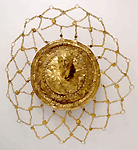 Stathatos
collection Stathatos
collection
The
Stathatos collection is housed in room 42. It includes 970 objects
ranging from the Middle Bronze Age to the post-Byzantine period
and in contains mainly jewelry, metal objects and pottery as well
as stone and ceramic vases.
Of
particular artistic value are considered the golden jewels of
the Hellenistic period from Demetrias in Thessaly and from Karpenissi.

Thera
collection
The
collection from Thera (Santorini) is displayed in room 48 on the
first floor. The impressive fresco's from Akrotiri, with their
vivid colors and wonderful composition, are justly considered
to be among the finest items of the museum‘s collections.
The fact that they have survived in such excellent condition is
due to the island’s volcanic explosion which covered the
houses of the prehistoric town in volcanic ash.
The
paintings include the scene of the naval expedition with the earliest
known depiction of a town in ancient Greek art, the images of
fisherman, monkeys, boxing children – one of the earliest
know depictions of a sport event in Greece and the fresco of the
spring. Apart from the paintings, visitors can also admire excellent
ceramics, bronze and stone artifacts from Thera. 
Pottery and small ornaments
The
pottery and small ornaments collection is on display in rooms
49 to 56 on the first floor. Representative finds from the Protogeometric
to the later Classical period (11th to 4th century BC) are arranged
in chronological order. Room 49 houses vases mainly from Attic
workshops found in the cemeteries of Nea Ionia, Areios Pagos,
Kerameikos and Dipylon.
In
this room, visitors can admire an amphora by the Dipylon Painter,
which shows a funeral procession similar to that in the sculptures
collection in room 7. There also are two terracotta heads of figurines
from the Amykaion in Lakonia. Room 50 shows Geometric vases and
figurines of various workshops (from Attica, Boeotia, Corinth,
Thessaly). One of the highlights is the Dipylon crater with its
big volume and high quality representation of a funeral procession.
Room
51 displays:
•
vases of the Orientalizing period (7th century BC) in the so
called Protoattic style
found in Attic cemeteries
• early Cycladic amphora’s, the so called Melian
amphora’s
• jugs in the wild goat style
• and various small scale artifacts.
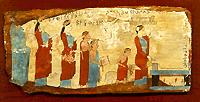 In
room 52 there is an exhibition of Corinthian, Attic and Boeotian
black-figured vases as well as a series of important votives
from the sanctuaries of Hera in Perachora and Argos, Artemis
Orthia in Sparta and Apollo in Thermon in Aetolia. Among the
most significant displays here are the ceramic model of a
temple from Heraion in Perachora, the painted metopes from
Thermon dating from the 7th century BC and the wooden panels
from Pitsas in Corinthia. In
room 52 there is an exhibition of Corinthian, Attic and Boeotian
black-figured vases as well as a series of important votives
from the sanctuaries of Hera in Perachora and Argos, Artemis
Orthia in Sparta and Apollo in Thermon in Aetolia. Among the
most significant displays here are the ceramic model of a
temple from Heraion in Perachora, the painted metopes from
Thermon dating from the 7th century BC and the wooden panels
from Pitsas in Corinthia.
In
room 53 black-figured vases of the 6th century BC are on display
as well as terracotta sarcophagi found during the excavations
in Clazomenai (1920-1921), small finds from various sanctuaries
in Athens and a selection of finds from Lemnos among which is
the stele of a warrior with an inscription in an Etruscan dialect.
Black-
and red-figured vases from the late Archaic period (500-480 BC)
and the early Classical period (480-460 BC) are in display in
room 54. In the next room there is an extensive collection of
Attic white urns mostly of Attic and Euboean provenance as well
as red-figured vases. Room 56 displays vases and figurines from
the late 5th and 4th century BC. 
The Epigraphic Museum
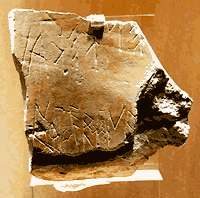 The
southern section of the National Archaeological Museum, with its
entrance on Tossitsa Street, houses the Epigraphic Museum, which
possesses the largest collection of Greek inscriptions in the
world, in total over 15.000. The museum was founded in 1885. It
was renovated and extended with six new rooms during the years
1953-1960 according to plans of the architect P. Karantinos. The
southern section of the National Archaeological Museum, with its
entrance on Tossitsa Street, houses the Epigraphic Museum, which
possesses the largest collection of Greek inscriptions in the
world, in total over 15.000. The museum was founded in 1885. It
was renovated and extended with six new rooms during the years
1953-1960 according to plans of the architect P. Karantinos.
The
earlier inscriptions are in room 11 while the most historically
significant inscriptions from various periods can be seen in room
9. The inscriptions in room 1 are the tribute lists of the First
Athenian Confederacy. These are invaluable documents for the study
of the history of Classical Greece. The earliest inscription from
this collection (454-453 BC) is an impressive block of stone of
3,5 meters (49,21ft) high.
 Opening hours and admission
Opening hours and admission
 28th October Street 24 known as Pattision Street
28th October Street 24 known as Pattision Street
 Victoria Victoria
 For typical words, please consult our Greek
Glossary
For typical words, please consult our Greek
Glossary
 National
Archaeological Museum photos
National
Archaeological Museum photos 

|



 The
Prehistoric collection is displayed in rooms 3 to 6 on the ground
floor. In room 5 there are Neolithic objects (6800-3300 BC) and
objects from the early and mid-Bronze period (3rd century BC and
2000-1700 BC). There are ceramic finds from the important Neolithic
sites at Dimini and Sesklo in Thessaly as well as early and middle
Helladic ceramics from various locations in Boeotia, Attica and
Phthiotis. Some objects from Schliemann’s excavations in
Troy are also on display.
The
Prehistoric collection is displayed in rooms 3 to 6 on the ground
floor. In room 5 there are Neolithic objects (6800-3300 BC) and
objects from the early and mid-Bronze period (3rd century BC and
2000-1700 BC). There are ceramic finds from the important Neolithic
sites at Dimini and Sesklo in Thessaly as well as early and middle
Helladic ceramics from various locations in Boeotia, Attica and
Phthiotis. Some objects from Schliemann’s excavations in
Troy are also on display. Most
notable are:
Most
notable are: There
also are finds from the vaulted tombs in Mycenae and other locations
in the Peloponnese (Tiryns and Dendra in Argolis, Pylos in Messinia
and Vafeio in Lakonia) including stone, bronze and ceramic pots,
figurines, ivory objects, golden seals and rings with precious
and semi-precious stones, glass and faience.
There
also are finds from the vaulted tombs in Mycenae and other locations
in the Peloponnese (Tiryns and Dendra in Argolis, Pylos in Messinia
and Vafeio in Lakonia) including stone, bronze and ceramic pots,
figurines, ivory objects, golden seals and rings with precious
and semi-precious stones, glass and faience.
 Room
18 displays gravestones including that of Hegeso (end of the 5th
century BC) from the cemetery of Kerameikos. The dead woman is
shown seated opposite a slave who is holding a jewel case (pyxis).
Rooms 19 and 20 include works from the Roman period, copies of
famous bronze sculptures of the Classical period. The importance
of the statue of Varvakeios Athena (3rd century BC) lays more
in its being a copy of the gold and ivory statue of Athena form
the Parthenon made by Pheidias, than in its aesthetic value.
Room
18 displays gravestones including that of Hegeso (end of the 5th
century BC) from the cemetery of Kerameikos. The dead woman is
shown seated opposite a slave who is holding a jewel case (pyxis).
Rooms 19 and 20 include works from the Roman period, copies of
famous bronze sculptures of the Classical period. The importance
of the statue of Varvakeios Athena (3rd century BC) lays more
in its being a copy of the gold and ivory statue of Athena form
the Parthenon made by Pheidias, than in its aesthetic value.  The
antiquities on display in room 36 once belonged to Konstantinos
Karaponas, a politician and amateur archaeologist from Ipiros.
They come from the excavations he conducted himself in Dodone
and Corfu but from purchase as well. The collection includes excellent
bronze objects, mostly statuettes, such as:
The
antiquities on display in room 36 once belonged to Konstantinos
Karaponas, a politician and amateur archaeologist from Ipiros.
They come from the excavations he conducted himself in Dodone
and Corfu but from purchase as well. The collection includes excellent
bronze objects, mostly statuettes, such as: Stathatos
collection
Stathatos
collection In
room 52 there is an exhibition of Corinthian, Attic and Boeotian
black-figured vases as well as a series of important votives
from the sanctuaries of Hera in Perachora and Argos, Artemis
Orthia in Sparta and Apollo in Thermon in Aetolia. Among the
most significant displays here are the ceramic model of a
temple from Heraion in Perachora, the painted metopes from
Thermon dating from the 7th century BC and the wooden panels
from Pitsas in Corinthia.
In
room 52 there is an exhibition of Corinthian, Attic and Boeotian
black-figured vases as well as a series of important votives
from the sanctuaries of Hera in Perachora and Argos, Artemis
Orthia in Sparta and Apollo in Thermon in Aetolia. Among the
most significant displays here are the ceramic model of a
temple from Heraion in Perachora, the painted metopes from
Thermon dating from the 7th century BC and the wooden panels
from Pitsas in Corinthia. The
southern section of the National Archaeological Museum, with its
entrance on Tossitsa Street, houses the Epigraphic Museum, which
possesses the largest collection of Greek inscriptions in the
world, in total over 15.000. The museum was founded in 1885. It
was renovated and extended with six new rooms during the years
1953-1960 according to plans of the architect P. Karantinos.
The
southern section of the National Archaeological Museum, with its
entrance on Tossitsa Street, houses the Epigraphic Museum, which
possesses the largest collection of Greek inscriptions in the
world, in total over 15.000. The museum was founded in 1885. It
was renovated and extended with six new rooms during the years
1953-1960 according to plans of the architect P. Karantinos.
















